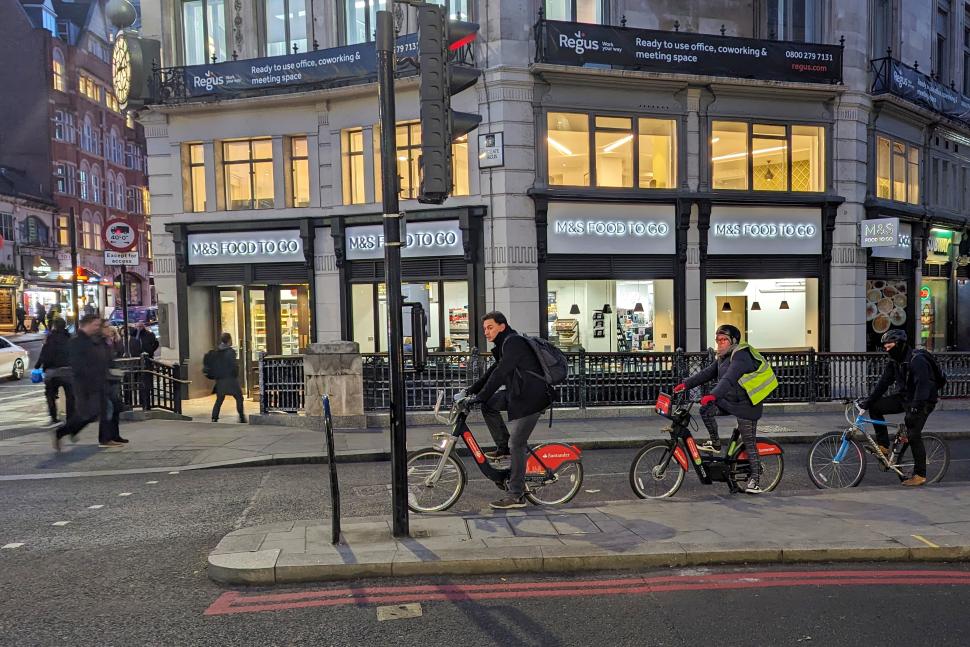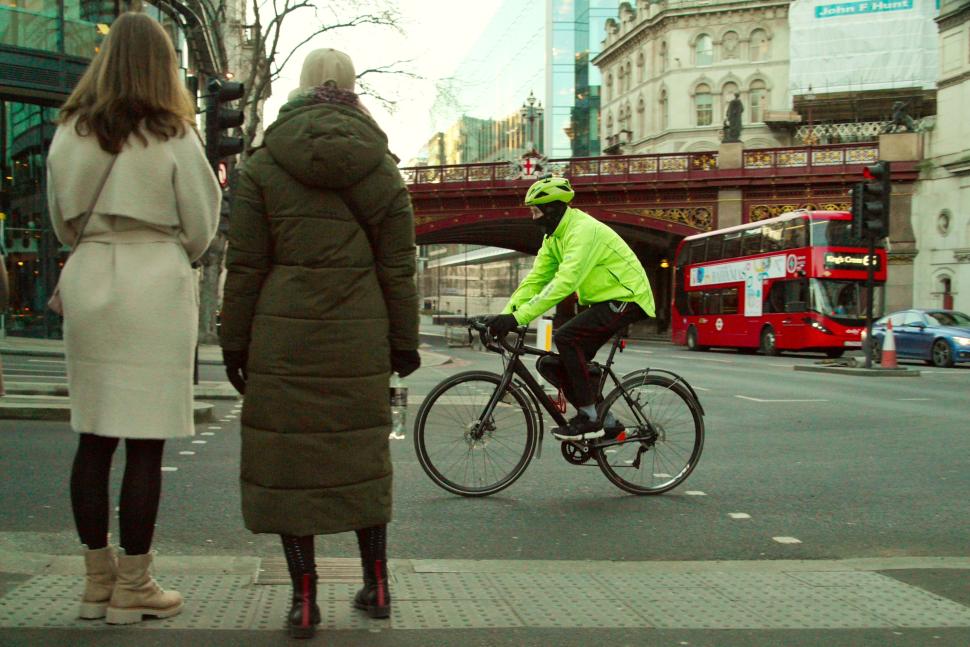The Labour government is set to introduce new ‘dangerous cycling’ laws which would bring punishments for cyclists who kill or injure by dangerous or careless riding in line with those for drivers.
Home Office officials say the changes will “make our streets safer for pedestrians” and “tackle those rare instances where victims have been killed or seriously injured by irresponsible cyclist behaviour”.
The introduction of such new laws is no surprise of course and has been expected for some time, the Home Office recently publishing an official document outlining the proposed changes and confirming this to road.cc this morning, although no timescale for potential legislation has been given.
They have also confirmed that there are no plans to extend speed limit legislation to cyclists.
 Cyclists at a red light 2.jpg (credit: road.cc)
Cyclists at a red light 2.jpg (credit: road.cc)
The previous Conservative government had been set to introduce ‘dangerous cycling’ legislation last year, but it was put on hold by the snap election. Labour pledged to follow through with the proposals when elected and, now almost 15 months on from the party’s landslide victory at the polls, the ‘dangerous cycling’ laws are edging closer.
It appears unlikely the changes would receive much opposition in Parliament, given it was the Conservatives, the party with the second most seats, who first proposed similar legislation last year — the campaign for updated ‘dangerous cycling’ laws spearheaded by former leader Iain Duncan Smith who made the case following a May 2024 inquest into the death of Hilda Griffiths, an 81-year-old woman who died in hospital two months after a collision with a cyclist riding laps of Regent’s Park in London as part of a group ride travelling at speeds between 25-29mph at the time of the crash.
The cyclist involved, Brian Fitzgerald, had no charges brought against him as the Metropolitan Police said there was “insufficient evidence for a real prospect of conviction”. The inquest received widespread media attention and Duncan Smith urged his government to introduce stricter laws for cyclists, legislation which looked set to be passed when the snap election was called.
Now, in a policy paper published earlier in the summer, and titled ‘Crime and Policing Bill: dangerous cycling offences factsheet’, the Home Office has outlined exactly what it is proposing. A spokesperson from the Home Office confirmed to us this morning this is the latest on the matter, although no timescale for legislation has been provided.
Hammersmith Bridge (credit: Simon MacMichael)
“We are making our streets safer for pedestrians, by introducing new cycling offences to tackle those rare instances where victims have been killed or seriously injured by irresponsible cyclist behaviour,” the Home Office says.
“What we are doing will not criminalise new behaviours. Instead, they will ensure that people who cause serious harm because of their bad cycling behaviour, which is already a criminal offence, are subject to penalties which are equivalent to those already in place if the same level of harm is caused by drivers of other vehicles.”
The bill would add “appropriate offences” to the Road Traffic Act 1988, with the corresponding maximum penalties being set out in the Road Traffic Offenders Act 1988. It would apply to England, Wales and Scotland.
The four offences and their maximum penalties that are being introduced are:
Causing death by dangerous cycling: On conviction on indictment, up to life imprisonment.
Causing serious injury by dangerous cycling: On conviction on indictment, five years’ imprisonment, a fine, or both. On summary conviction, the general limit in a magistrates’ court (currently 12 months) (in England and Wales), or 12 months (in Scotland); or the statutory maximum fine, or both.
Causing death by careless or inconsiderate cycling: On conviction on indictment, five years’ imprisonment, a fine, or both. On summary conviction, the general limit in a magistrates’ court (currently 12 months) (in England and Wales), or the maximum term of imprisonment on summary conviction (currently 12 months) (in Scotland); or the statutory maximum fine, or both.
Causing serious injury by careless or inconsiderate cycling: On conviction on indictment, two years’ imprisonment, a fine, or both. On summary conviction, the general limit in a magistrates’ court (currently 12 months) (in England and Wales), or the maximum term of imprisonment on summary conviction (currently 12 months) (in Scotland); or the statutory maximum fine or both.
Of course, while these are maximum sentences listed, in reality the sentences currently handed out to motorists for offences that these are to be brought in line with are often far shorter.
 Cyclists in London stopped at red light (credit: Simon MacMichael)
Cyclists in London stopped at red light (credit: Simon MacMichael)
For example, last week we reported that a delivery driver — who was reading paperwork and failing to concentrate on the road when he struck and killed a father of two cycling to work — was jailed for six years for causing death by dangerous driving.
Likewise, last November a dangerous driver who killed a cyclist in Cheshire was jailed for four years. Seena Chacko had no licence or insurance and continued to drive with the victim’s bike underneath their vehicle until they were stopped by another motorist.
The Home Office says that in 2023 “there were four fatalities and 185 serious injuries where a pedestrian was hit by a cyclist”. The department points out that cyclists can currently be prosecuted under the offences of dangerous, and careless or inconsiderate, cycling (maximum penalty £2,500 fine for dangerous cycling, £1,000 for careless), wanton and furious driving (maximum penalty two years’ imprisonment), and riding a cycle while unfit due to drink or drugs (maximum penalty £1,000 fine).
 Cyclists at traffic lights, London (credit: Simon MacMichael)
Cyclists at traffic lights, London (credit: Simon MacMichael)
However, the Home office says these maximum penalties “are not adequate for those incidents that result in serious or fatal injury”. The department’s own statistics highlight that over the last 10 years, an average of three pedestrians have been killed per year by cyclists. In the same time period, an average of 283 pedestrians were killed per year in collisions involving drivers of cars.
44 cyclists were prosecuted or convicted for careless cycling in 2023, compared to the previous year’s total of 47. Five cyclists were prosecuted or convicted for reckless or dangerous cycling in 2023 (the same number as 2022).
“No pedestrian should feed unsafe. Protecting pedestrians and all road users is a priority for this government,” the Home Office continued.
“It is important to ensure there is an appropriate framework of offences to punish dangerous and careless behaviour that results in serious harm to other road users. These new offences introduce penalties which are equivalent to those already in place if the same level of harm is caused by drivers of other vehicles.
 Cyclists and pedestrians in Castle Park, Bristol (credit: Adwitiya Pal)
Cyclists and pedestrians in Castle Park, Bristol (credit: Adwitiya Pal)
“In rare, tragic cases that have occurred in recent years, the drawbacks of relying on the current offences, notably the Offences Against the Person Act 1861 have been clear. The bill will rectify this, bringing these offences into line with motoring offences. It will ensure the penalties are equivalent to those already in place, if the same of level of harm is caused by drivers of other vehicles.”
The Home Office has confirmed that there are no plans to extend speed limit regulations to cyclists, arguing that cyclists “can still be charged with careless or dangerous cycling offences depending on the circumstances”.
“But people who cycle have a duty, like all road users, to behave in a safe and responsible manner,” the paper continued. “For those who do not adopt a responsible attitude, or if their use of the highway creates an unsafe environment or causes nuisance, laws such as the current offences of dangerous or careless cycling can make them liable for prosecution. The police are responsible for enforcement of road traffic law.”

